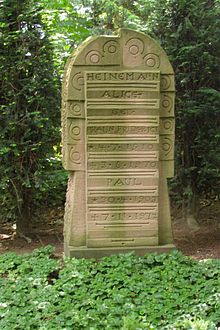Heinemann burial site (Mönchengladbach)
The Heinemann grave is located in Mönchengladbach ( North Rhine-Westphalia ) on the main municipal cemetery , Peter-Nonnenmühlen-Allee.
It was built in 1972 and entered in the monuments list of the city of Mönchengladbach on November 15, 2012 under No. P 020 .
location
The grave of the Heinemann family is in the southern part of the city's main cemetery (A, 02, 0031 and 0032) not far from the Hochkreuz.
description
The Mönchengladbach sculptor Klaus Iserlohe designed and sculpted a tombstone for the grave of the Heinemann family . Because of family relationships, Iserlohe used the red variety of red sandstone made from cord in the Eifel (Voltziensandstein / Oberer Buntsandstein / Trias).
The circumferential edge of the approx. 20-25 cm thick stone slab is roughly sharpened, the visible surface shows planes that are ground in several levels and that are offset against each other in steps. In the middle is a rectangular area differentiated by horizontal bands. Stripes structured by horizontal lines alternate with recessed stripes. The latter bear the names and dates of the deceased; the family name closes the area at the top. The lower, polished third of the stone tapers slightly conically upwards, then becomes wider and ascending and then merges into a semicircular arc that ends with a step offset in the middle. This upper, highlighted level also shows horizontally aligned, but wider stripes, each of which has graphic symbols - a full circle, framed by a semicircle on the outside.
The inscription reads:
HEINEMANN
ALICE
GEB.
BRAUN-FRIDERICI
- 4.7.1910
† June 3, 1970
PAUL
- April 30, 1903
† November 7, 1972
Iserlohe conceived and implemented his sculptural work graphically. This is shown e.g. B. very expressive on the grave slabs of the Aachen bishops Pohlschneider and Hemmerle or on the altar panel of the altar in the monastery church Neuwerk .
Despite slight three-dimensional internal differentiations, the gravestone appears more two-dimensional due to its distinctive graphic design. The grave monument takes on the Christian theme of the tree of life and abstracts it into sculpture. The upright rectangular area represents the trunk of the tree with its structured bark. The back and the upwardly rounded surface stand for its foliage, for branches and leaves. The direct connection between the tribe and the name means that the deceased are closely theologically involved in the symbolism; they are inscribed in the tree of life in life as in death.
The tombstone is well preserved.
The object is significant
1. for human history,
2. for cities and settlements.
There is a public interest in its preservation and use
1.Artistic reasons (rare example of a profane sculptural work by the nationally working artist Klaus Iserlohe; outstanding design quality as a tombstone, especially in comparison to the mass-produced goods in the cemetery at the same time; three-dimensional graphic implementation of the Christian theme of life / death / resurrection)
2. For reasons of local history (work by the sculptor Klaus Iserlohe; tombstone of the Heinemann family).
Web links
- List of monuments of the city of Mönchengladbach. (PDF) In: moenchengladbach.de. City of Mönchengladbach, July 4, 2011, accessed on June 2, 2012 (234.24 kB).
- Käthe Limburg, Bernd Limburg: Monuments in the city of Mönchengladbach. In: on the way & at home - homepage of Käthe and Bernd Limburg. July 18, 2011, accessed February 27, 2014 .
Individual evidence
- ^ Monuments list of the city of Mönchengladbach , November 16, 2018, accessed on July 29, 2019
Coordinates: 51 ° 12 ′ 40.4 " N , 6 ° 25 ′ 36.4" E
